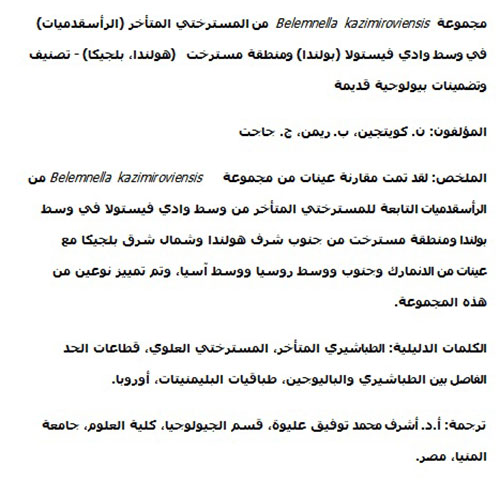The late Maastrichtian Belemnella kazimiroviensis group (Cephalopoda, Coleoidea) in the Middle Vistula valley (Poland) and the Maastricht area (the Netherlands, Belgium) – taxonomy and palaeobiological implications
Plain Language Abstract
Near the end of the Cretaceous Period, during the late Maastrichtian, belemnitellid squid-like cephalopods of the Belemnella kazimiroviensis group appeared in central and western Europe, first in Poland (Middle Vistula River valley) and Denmark, later in the southeast Netherlands and northeast Belgium. This highly successful group probably had its origin in the eastern part of the Russian Platform, close to the beginning of the late Maastrichtian. Representatives of the Belemnella kazimiroviensis group dominated the belemnite record at the end of the Maastrichtian Stage, but became extinct, together with other members of the family Belemnitellidae, close to or at the Cretaceous-Paleogene (K-Pg) boundary.
We have studied the late Late Maastrichtian belemnitellid coleoids of the Belemnella kazimiroviensis group from the two key European sections, i.e., the Middle Vistula valley in central Poland and the Maastricht area in the southeast Netherlands and northeast Belgium and compared this material with material from Denmark, southern and central Russia, and Central Asia. In comparison to former researchers, we recognised only two species within this successful linage: Belemnella (Neobelemnella) kazimiroviensis (Skołozdrówna, 1932) and Belemnella (Neobelemnella) skolozdrownae (Kongiel, 1962). Populations of the kazimiroviensis group in the Nasiłów and Maastricht areas were both dominated by relatively small individuals, which might suggest that a significant number of specimens did not reach the reproductive age or changed habitat during their life cycle. Although part of the studied belemnites came already from the Paleogene deposits, we have found no evidence that they survived the catastrophe that happened some 65 millions of years ago, and this material for the time being must be interpreted as reworked.
Resumen en Español
El grupo Belemnella kazimiroviensis del Maastrichtiense tardío (Cephalopoda, Coleoidea) en el valle del Vístula Medio (Polonia) y el área de Maastricht (Países Bajos, Bélgica) - taxonomía e implicaciones paleobiológicas
Se han estudiado y comparado los Coleoidea del grupo Belemnella kazimiroviensis del Maastrichtiense tardío de secciones clave en el valle del Vístula Medio en Polonia central y del área de Maastricht en el sureste de los Países Bajos y el noreste de Bélgica con materiales de Dinamarca, Rusia meridional y central, y Asia central tal y como han sido figurados en la bibliografía. Se reconocen dos especies: Belemnella (Neobelemnella) kazimiroviensis (Skołozdrówna, 1932) y Belemnella (Neobelemnella) skolozdrownae (Kongiel, 1962). Las poblaciones del grupo kazimiroviensis en las zonas de Nasiłów y Maastricht estaban dominadas por individuos relativamente pequeños, lo que podría sugerir que un número significativo de especímenes no alcanzó la edad reproductiva o cambió el hábitat durante su ciclo de vida. Aunque parte de los belemnites estudiados provinieron de los depósitos del Paleógeno, no hemos encontrado ninguna evidencia que indique que sobrevivieron más allá del límite de K-Pg, por lo que se interpretan como ejemplares reelaborados.
Palabras clave: Cretácico tardío; Maastrichtiense superior; secciones del límite K-Pg; estratigrafía de belemnites; Europa
Traducción: Enrique Peñalver (Sociedad Española de Paleontología)
Résumé en Français
Le groupe Belemnella kazimiroviensis (Cephalopoda, Coleoidea) du Maastrichtien récent de la moyenne vallée de la Vistule (Pologne) et de la région de Maastricht (Pays-Bas, Belgique) – taxinomie et implications paléobiologiques
Les coléoïdes belemnitellidés du groupe Belemnella kazimiroviensis datant du Maastrichtien récent des sections clés de la moyenne vallée de la Vistule, au centre de la Pologne et dans la région de Maastricht au sud-est des Pays-Bas et au nord-est de la Belgique, ont été étudiés et comparés avec du matériel du Danemark, du sud et du centre de la Russie, et d'Asie centrale d'après les illustrations de la littérature. Deux espèces sont reconnues : Belemnella (Neobelemnella) kazimiroviensis (Skołozdrówna, 1932) et Belemnella (Neobelemnella) skolozdrownae (Kongiel, 1962). Les populations du groupe B. kazimiroviensis dans les régions de Nasiłów et Maastricht étaient dominées par des individus relativement petits, ce qui pourrait suggérer qu'un nombre important de spécimens n'atteignaient pas l'âge reproductif ou changeaient d'habitat pendant leur cycle de vie. Bien qu'une partie des bélemnites étudiées viennent de dépôts paléogènes, nous n'avons trouvé aucune preuve qu'elles aient survécu à l'extinction Crétacé-Tertiaire, et elles sont donc interprétées comme remaniées.
Mots-clés : Crétacé récent ; Maastrichtien supérieur ; sections de la limite Crétacé-Tertiaire ; stratigraphie des bélemnites ; Europe
Translator: Antoine Souron
Deutsche Zusammenfassung
Die Belemnella kazimiroviensis Gruppe (Cephalopoda, Coleoidea) aus dem späten Maastricht des Mittleren Vistula Tals (Polen) und des Maastricht Gebiets (Niederlande, Belgien) – Taxonomie und paläobiologische Rückschlüsse
Die belemnitelliden Coleoiden aus dem späten Maastricht der Belemnella kazimiroviensis Gruppe aus zentralen Gebieten des mittleren Vistula Tals in Zentralpolen und dem Maastricht Gebiet im Südwesten der Niederlande und in Nordost Belgien wurden untersucht und mit Material aus Dänemark, Süd-und Zentralrussland und Zentralasien aus der Literatur verglichen. Es wurden zwei Arten erkannt: Belemnella (Neobelemnella) kazimiroviensis (Skołozdrówna, 1932) und Belemnella (Neobelemnella) skolozdrownae (Kongiel, 1962). Die Populationen der kazimiroviensis-Gruppe im Nasiłów und Maastricht Gebiet werden beide von relativ kleinen Individuen dominiert, was möglicherweise darauf hindeutet, dass eine erhebliche Anzahl an Tieren das Fortpflanzungsalter nicht erreichte oder während des Lebenszyklus das Habitat wechselte. Obwohl ein Teil der untersuchten Belemniten aus paläogenen Ablagerungen stammt, haben wir keine Beweise gefunden, dass sie die K/Pg Grenze überlebt haben und so interpretieren wir diese Gegebenheit als aufgearbeitet.
Schlüsselwörter: späte Kreide; oberes Maastricht; K/Pg Grenzbereiche; Belemniten-Stratigraphie; Europa
Translator: Eva Gebauer
Arabic

Translator: Ashraf M.T. Elewa

